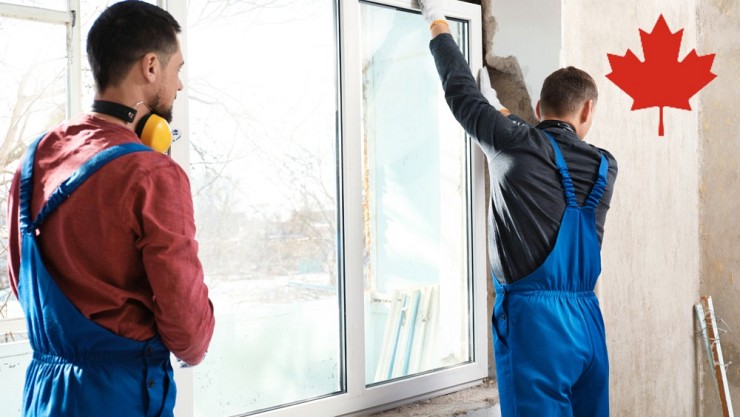Step-by-Step Guide to Window Grants in Canada in 2025

Replacing your windows isn’t cheap. But the Canadian government is handing out money to help.
In 2025, there are several grants and rebate programs available that can help Canadian homeowners cover the cost of energy-efficient window upgrades.
The main reason? Energy-efficient windows can lower your heating and cooling bills, while also reducing your home's environmental impact.
But like most government programs, the application process can feel overwhelming.
That’s where this guide comes in.
Below, you’ll find a simple, step-by-step breakdown of how to apply for window replacement grants in Canada. We’ll cover federal programs, provincial rebates, eligibility requirements, and everything else you need to know to get started.
Step 1: Understand Available Window Grants in Canada

There isn’t just one grant for window replacements in Canada. There are multiple programs you can apply for, depending on where you live and what kind of upgrades you’re doing.
Here’s a quick breakdown:
Federal Programs
This is the most popular option. The program offers up to $5,000 for eligible energy-efficient upgrades, including windows and doors.
If you're planning a bigger renovation, this program offers interest-free loans up to $40,000 for qualified retrofits. Windows count here too.
Provincial Programs
Each province has its own set of rebates and grants. A few examples:
- Ontario: Home Efficiency Rebate Plus (HER+), up to $10,600 in rebates.
- British Columbia: CleanBC Better Homes Program, offers various rebates for high-performance windows.
- Alberta: Depending on the year, provincial programs may be available (always check current options).
Municipal or Utility Rebates
Some cities and utility companies also offer rebates:
- Hydro companies
- Gas providers like Enbridge
- Local green home initiatives
Note: Programs change often. Always check the most up-to-date information when you’re ready to apply.
Step 2: Check Your Eligibility
Before you apply, you need to make sure you actually qualify. Each program has its own rules, but most of them look at a few basic factors:
Homeownership
- You need to own the home you’re upgrading.
- Some programs also allow landlords or multiple property owners to apply.
Property Type
- Detached, semi-detached, townhomes, mobile homes, and low-rise multi-units often qualify.
- Condos and high-rises usually don’t unless you’re responsible for your unit’s windows.
Window Condition
- Most grants are for replacements, not repairs.
- The windows you install must meet ENERGY STAR® or program-specific energy efficiency standards.
Income Level
- Some programs may offer additional help for low-to-moderate income households.
- Income-based eligibility varies by province or municipality.
- Quick Tip: Even if you’re not sure, it’s worth applying. Programs are designed to encourage participation.
Quick Tip: Even if you’re not sure, it’s worth applying. Programs are designed to encourage participation.
Step 3: Get a Pre-Assessment or Energy Audit
In most cases, you can’t just replace your windows and submit the receipt. An energy assessment (also called an energy audit) is usually required before you start.
Why It’s Required
- It helps identify which upgrades make the most sense for your home.
- Verifies your eligibility for the grant.
- The audit results are submitted as part of your application.
How to Book One
- You’ll need a certified energy advisor registered with Natural Resources Canada.
- Costs typically range from $300 to $600, but some programs reimburse this after you complete the upgrades.
Pro Tip: Don’t skip this step. If you replace your windows before getting an audit, you may lose your eligibility.
Step 4: Choose Eligible Windows and Contractors
Not every window qualifies for a grant. To get approved, you need to follow specific rules when choosing your windows and who installs them.
Eligible Windows
- The windows must be ENERGY STAR® certified for your climate zone.
- In some cases, you may need to choose high-performance models that meet stricter energy efficiency standards.
- Look for U-Factor and Energy Rating (ER) scores that meet or exceed the program’s requirements.
Quick Tip: ENERGY STAR keeps a searchable list of qualifying products. Check it before you buy.
Approved Contractors
- Some programs may require you to use certified or licensed contractors.
- Even if it’s not mandatory, using experienced professionals helps ensure your installation meets standards.
- Always ask for detailed invoices; you’ll need them when applying for reimbursement.
Pro Tip: Keep all documentation; contracts, invoices, window specs, and product certifications. You’ll need these for your application.
Step 5: Apply for the Grant
Once your audit is done and you’ve selected your windows and contractor, it’s time to apply.
How to Apply
- Most programs offer online applications through government or utility portals.
- You’ll submit your pre-audit report, quotes, and contractor information.
- Some programs allow you to apply before or after the work is completed, read the rules carefully.
What You’ll Need
- Proof of homeownership (property tax bill, mortgage statement, etc.)
- Energy audit reports (pre- and eventually post-retrofit)
- Detailed invoices showing window models, costs, and installation dates
- Contractor information and license (if required)
Common Mistakes to Avoid
- Replacing windows before completing your pre-audit
- Missing or incomplete documentation
- Applying for the wrong program or missing deadlines
Pro Tip: Set reminders for deadlines. Many programs have limited funds and strict cut-off dates.
Step 6: Complete Post-Upgrade Inspection (If Required)
After your new windows are installed, many programs require a post-retrofit energy audit to verify the work was completed correctly.
Why This Step Matters
- Confirms your upgrades meet the program’s energy efficiency standards.
- Ensures you get the full grant amount you’re eligible for.
- Required for final grant approval in most federal and provincial programs.
Booking Your Post-Audit
- Use the same energy advisor who did your initial assessment.
- Schedule the inspection soon after the installation is complete.
- Provide your advisor with all relevant documentation (invoices, window specs, etc.).
Note: Skipping this step can delay or disqualify your rebate.
Step 7: Receive Your Grant or Rebate
Once your post-retrofit audit is complete and approved, the final step is to collect your money.
Payment Timeline
- Processing times vary by program but typically take 6 to 12 weeks.
- Payments are usually made via direct deposit or cheque.
What If There’s a Problem?
- If any issues come up (missing documents, audit discrepancies, etc.), the program administrators will contact you.
- Respond quickly to avoid further delays.
Pro Tip: Keep copies of all paperwork for at least a year after receiving your grant.
Final Thoughts
Getting a government grant for window replacement in Canada takes a bit of planning, but the savings can be well worth the effort.
By following the proper steps, from your energy audit to your final post-inspection, you can make your home more energy-efficient while getting thousands of dollars back in rebates.
Don’t wait too long. Many of these programs have limited funding and deadlines.











